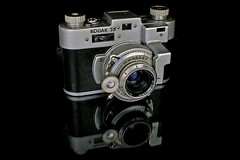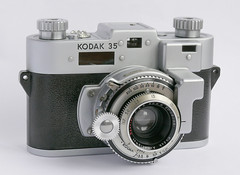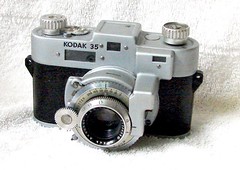Difference between revisions of "Kodak 35 RF"
m (Added image permission.) |
(rephrasing) |
||
| Line 6: | Line 6: | ||
}} | }} | ||
| − | A contemporary of the [[Argus C3]] and the [[Mercury|Universal Mercury]], [[Kodak]] 35 RF astonished users with | + | A contemporary of the [[Argus C3]] and the [[Mercury|Universal Mercury]], [[Kodak]] 35 RF astonished users with its ungainly looks, due to the coupling between the [[rangefinder (device)|rangefinder]] and the focusing mechanism which was accomplished by a cam and levers located under an external housing. |
| − | The camera is basically a [[Kodak 35]] with the addition of a new cover containing a fixed viewfinder, film counter, wind and rewind knobs, and the separate rangefinder window. The rangefinder, an obvious afterthought, was incorporated in response to the | + | The camera is basically a [[Kodak 35]] with the addition of a new cover containing a fixed viewfinder, film counter, wind and rewind knobs, and the separate rangefinder window. The rangefinder, an obvious afterthought, was incorporated in response to the marketing success of the [[Argus]] C series. It is quite accurate and easy to use and very capable of producing excellent results, even by modern standards. |
Like the [[Kodak 35]], the rangefinder model is solidly crafted out of [[Bakelite]] with numerous metallic panels, inserts and fittings. The back removes completely for film loading. | Like the [[Kodak 35]], the rangefinder model is solidly crafted out of [[Bakelite]] with numerous metallic panels, inserts and fittings. The back removes completely for film loading. | ||
| Line 23: | Line 23: | ||
The two lens offerings were optically identical, differing only in name and the inclusion of flash synchronization. | The two lens offerings were optically identical, differing only in name and the inclusion of flash synchronization. | ||
| − | The Kodak 35 | + | The Kodak 35 RF originally sold in 1940 for a list price of $48 USD<ref>History of Kodak Cameras at www.kodak.com</ref> (app. $700 USD in 2007). As this was almost double the price of the Argus C3, it is easy to see why the Kodak 35 Rangefinder model suffered from lackluster sales. |
== Gallery == | == Gallery == | ||
{{Flickr image | {{Flickr image | ||
| − | | image_source=http://www.flickr.com/photos/9010347@N08/1129474369/in/pool- | + | | image_source=http://www.flickr.com/photos/9010347@N08/1129474369/in/pool-camerawiki/ |
| image=http://farm2.static.flickr.com/1356/1129474369_037489fe2d_m.jpg | | image=http://farm2.static.flickr.com/1356/1129474369_037489fe2d_m.jpg | ||
| image_align=right | | image_align=right | ||
| Line 33: | Line 33: | ||
}} | }} | ||
{{Flickr image | {{Flickr image | ||
| − | | image_source= http://www.flickr.com/photos/73598079@N00/147141596/in/pool- | + | | image_source= http://www.flickr.com/photos/73598079@N00/147141596/in/pool-camerawiki/ |
| image= http://static.flickr.com/51/147141596_36ebe2147a_m.jpg | | image= http://static.flickr.com/51/147141596_36ebe2147a_m.jpg | ||
| image_align= | | image_align= | ||
| Line 39: | Line 39: | ||
}} | }} | ||
{{Flickr image | {{Flickr image | ||
| − | | image_source=http://www.flickr.com/photos/jeronimogirona/453675540/in/pool- | + | | image_source=http://www.flickr.com/photos/jeronimogirona/453675540/in/pool-camerawiki/ |
| image=http://farm1.static.flickr.com/193/453675540_6def574bf3_m_d.jpg | | image=http://farm1.static.flickr.com/193/453675540_6def574bf3_m_d.jpg | ||
| image_align= | | image_align= | ||
| Line 52: | Line 52: | ||
* Coe, Brian, ''Kodak Cameras, the First Hundred Years'', Hove Foto Books, 1988 | * Coe, Brian, ''Kodak Cameras, the First Hundred Years'', Hove Foto Books, 1988 | ||
* Kalton Lahue and Joesph Bailey, ''Glass, Brass, & Chrome - The American 35mm Miniature Camera'', University of Oklahoma Press, 1972 | * Kalton Lahue and Joesph Bailey, ''Glass, Brass, & Chrome - The American 35mm Miniature Camera'', University of Oklahoma Press, 1972 | ||
| − | |||
| − | |||
| − | |||
| − | |||
== Links == | == Links == | ||
Revision as of 07:38, 28 March 2011

|
by Kenneth Dwain Harrelson (Image rights) |
A contemporary of the Argus C3 and the Universal Mercury, Kodak 35 RF astonished users with its ungainly looks, due to the coupling between the rangefinder and the focusing mechanism which was accomplished by a cam and levers located under an external housing.
The camera is basically a Kodak 35 with the addition of a new cover containing a fixed viewfinder, film counter, wind and rewind knobs, and the separate rangefinder window. The rangefinder, an obvious afterthought, was incorporated in response to the marketing success of the Argus C series. It is quite accurate and easy to use and very capable of producing excellent results, even by modern standards.
Like the Kodak 35, the rangefinder model is solidly crafted out of Bakelite with numerous metallic panels, inserts and fittings. The back removes completely for film loading.
Contents
Specifications
- Manufacturer: Kodak
- Origin: USA
- Introduced: 1940
- Withdrawn: 1951
- Lens/Shutters:
- Kodak Anastigmat Special f3.5 a five speed Kodamatic shutter (1/10 to 1/200 plus T and B) (1940-48)
- Kodak Anastar f3.5 in a five speed Flash Kodamatic shutter 1/10 to 1/200 plus T and B) (1947-51)
The two lens offerings were optically identical, differing only in name and the inclusion of flash synchronization.
The Kodak 35 RF originally sold in 1940 for a list price of $48 USD[1] (app. $700 USD in 2007). As this was almost double the price of the Argus C3, it is easy to see why the Kodak 35 Rangefinder model suffered from lackluster sales.
Gallery

|
by poltag |

|
by Rick Zolla |

|
by Girolamo |
References
- ↑ History of Kodak Cameras at www.kodak.com
Source
- Coe, Brian, Kodak Cameras, the First Hundred Years, Hove Foto Books, 1988
- Kalton Lahue and Joesph Bailey, Glass, Brass, & Chrome - The American 35mm Miniature Camera, University of Oklahoma Press, 1972
Links
- Camera Collecting and Restoration: Kodak 35 RF, on Daniel R. Mitchell's website
- Kodak 35 RF, User manuals: 1, 2; on www.collection-appareils.fr by Sylvain Halgand
- Kodak 35 PDF manual, on OrphanCameras.com
- Kodak 35 RF, by Daniel Jiménez, at Del infinito al plano focal (in Spanish)